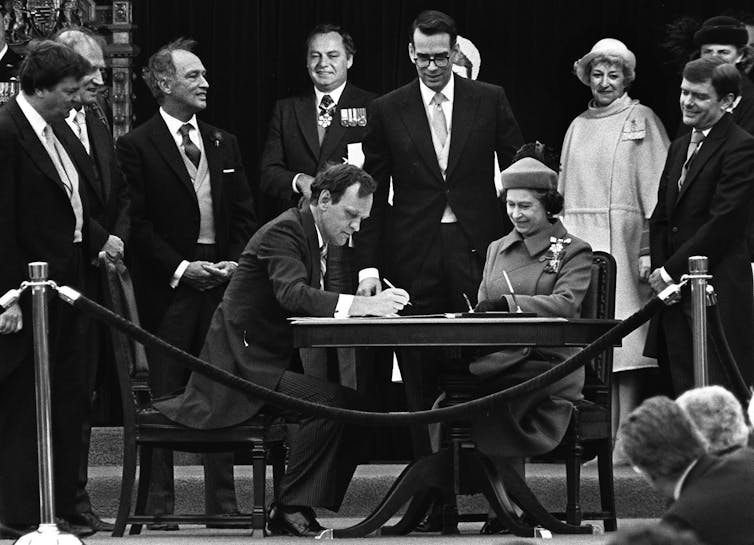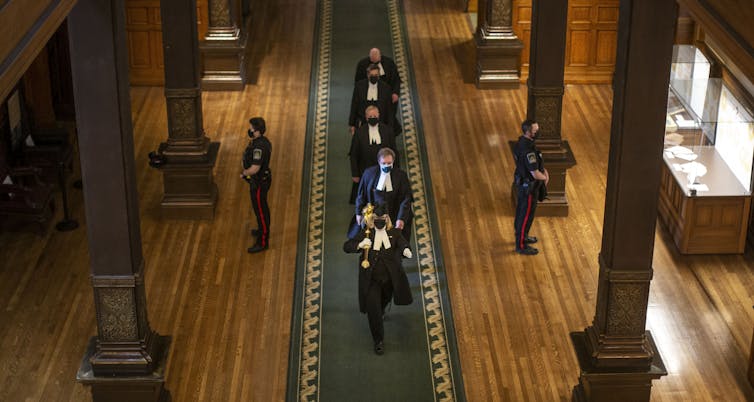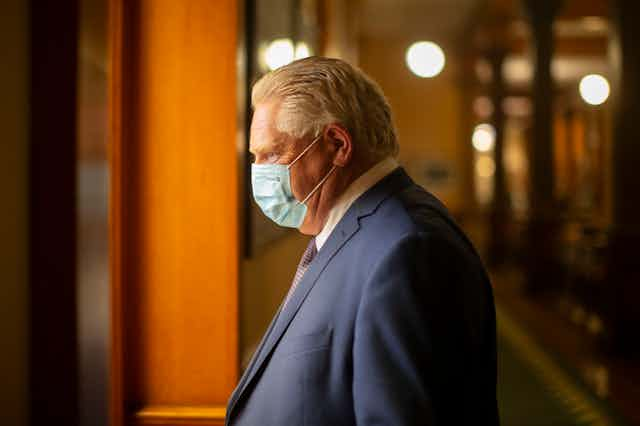Canadian politicians are beginning to use the Constitution’s notwithstanding clause more than ever expected, raising questions about when it’s legitimate to override rights guaranteed by the Charter of Rights and Freedoms.
Ontario Premier Doug Ford recently invoked the clause (Sec. 33 of the Charter) to pass a bill limiting third-party election advertising following a court’s decision that found the bill unconstitutional. Invoking Sec. 33 allows a government to override certain Charter rights, in this case freedom of expression.
In Québec, Premier François Legault invoked Sec. 33 to pass Bill 21, a secularism law prohibiting civil servants from displaying religious symbols. Bill 96, proposing reforms relating to the French language, also invokes Sec. 33.
Sec. 33 of the Charter allows a government to declare that a law will operate despite — in other words, notwithstanding — one or more Charter guarantees under Sec. 2 or Secs. 7 to 15.
Invoking the clause allows an unconstitutional law to operate for five years, whereupon it can be renewed for another five years under what’s known as “the sunset clause.”
Read more: The history of the notwithstanding clause
The origins of Sec. 33
While the origins of the notwithstanding clause remain murky, the 1960 Canadian Bill of Rights included something similar, used famously during the FLQ crisis to shield legislation replacing the War Measures Act from human rights scrutiny.
The notwithstanding clause proved crucial to securing the provinces’ consent to the Charter’s creation in 1982. The clause was part of a “package deal” — known as the “Kitchen Accord” — late in the November 1981 First Ministers Conference when hopes for an agreement were fading. It’s no exaggeration to say, as former Ontario premier Bob Rae recently recalled, there wouldn’t have been a Charter without it.
But the clause was hardly considered run-of-the-mill political device.
It was meant to be used only rarely, in the event of a court decision disagreeing with a province’s interpretation of a right. The sunset clause reflects the belief of Sec. 33’s creators that democratically unjustifiable uses of it would ultimately be punished by voters.

Contemporary critics
Today, reactions to politicians’ more frequent use of Sec. 33 fall into two opposing camps.
Those in the first camp see little problem with the clause. Sec. 33, they argue, was designed to give legislators the “last word” on the interpretation of constitutional rights when they fundamentally disagree with judges’ interpretations.
They argue most restrictions on the clause’s use are merely procedural, giving courts virtually no say on how governments use Sec. 33.
Those in the second camp oppose normalizing the use of the notwithstanding clause, arguing that courts have more power to review laws invoking Sec. 33 than the first camp suggests. Individuals or groups may challenge a law shielded by Sec. 33 in court, and a court can expressly declare that the law violates the Charter, even though the law will remain in effect.
Read more: Doug Ford uses the notwithstanding clause for political benefit
The second camp argues that the courts’ impartial reasoning will help citizens judge their government’s use of Sec. 33. The judicial process is also an avenue for minorities whose voices may be ignored by governments. And judicial decisions might alter a protected law’s political standing, forcing a government to change its policy or even revoke its Sec. 33 override.
Neither camp’s argument is complete, nor completely sincere.
The first camp’s view of Sec. 33 is grounded in a fundamental distrust of unelected — and often fallible — judges. This camp is opposed to the courts undermining the political will of a democratic majority.
The second camp fundamentally distrusts democratic politics. It vastly overestimates courts’ superior power to effectively explain what the law is and what the law should be.
Respecting history, looking forward
Can we reconcile these camps’ positions on the notwithstanding clause? By paying greater attention to the originally intended application of the clause along with the diversity of lawmakers in Canada, we propose a fresh alternative.
The starting point is the Supreme Court of Canada’s 1988 decision in the case of Ford v Québec. That case concerned the validity of a law mandating French-only signs in Québec, which the provincial government shielded from judicial review by invoking Sec. 33.
The Supreme Court ruled that Sec. 33 is subject only to minimal procedural requirements. All a government needs to do to shield a law from the Charter is refer to the Charter provisions that the government’s proposed law overrides. Or it can simply make a blanket statement that the law operates notwithstanding all the rights referenced in Sec. 33.
The Supreme Court’s decision in Ford v Québec must be updated.
In 1988, the court could reasonably conclude that simply referring to the Charter section that a law overrides was “a sufficient indication to those concerned of the relative seriousness” of the violation.
That was in line with the original intention of the clause. But it doesn’t serve the present needs of Canada. Both need to be taken into account.
We propose adding three procedural requirements governments must meet to legitimately invoke Sec. 33:
(1) Governments must give broad public notice of their intention to invoke Sec. 33 to pass a law violating one or more Charter guarantees, and they must clearly spell out those guarantees;
(2) Governments must facilitate meaningful public deliberation of the merits of their proposed laws and their reasons for violating — potentially or actually — one or more Charter guarantees; and
(3) When an individual or group goes to court to challenge the validity of a law shielded from Charter scrutiny, the government must not pass the law until the process is complete.
Addressing shortcomings
These additional requirements remedy the shortcomings of both Sec. 33 camps’ positions.
First, they integrate Sec. 33 with the Charter as a whole, whereas the first camp sees Sec. 33 as an independent Charter “no-go zone.” Our proposal corrects this camp’s error of prioritizing Sec. 33 over the rest of the Charter.
Second, these requirements give courts that scrutinize laws invoking Sec. 33 a more meaningful role beyond merely declaring that a law violates the Charter, which can confuse rather than inform the public and also risks politicizing our courts. That’s an American dilemma Sec. 33 was also originally intended to avoid.

Under our proposal, courts can ensure governments that invoke Sec. 33 are directly informing citizens of the relative seriousness of the Charter violations they propose, which was the real crux of Ford v Québec. Courts can rule that a law invoking the notwithstanding clause is not enforceable if the government has failed to meet these requirements, and can order the government to do so.
This will better ensure governments are held democratically accountable for invoking Sec. 33, not only by courts, but also by civil society, the media, academics, advocates, administrative agencies, private interests, minority constituencies — the raucous choir of everyday law in Canada.
Notwithstanding Sec. 33, the Constitution is a concern of all Canadians, and they should have the last word.

